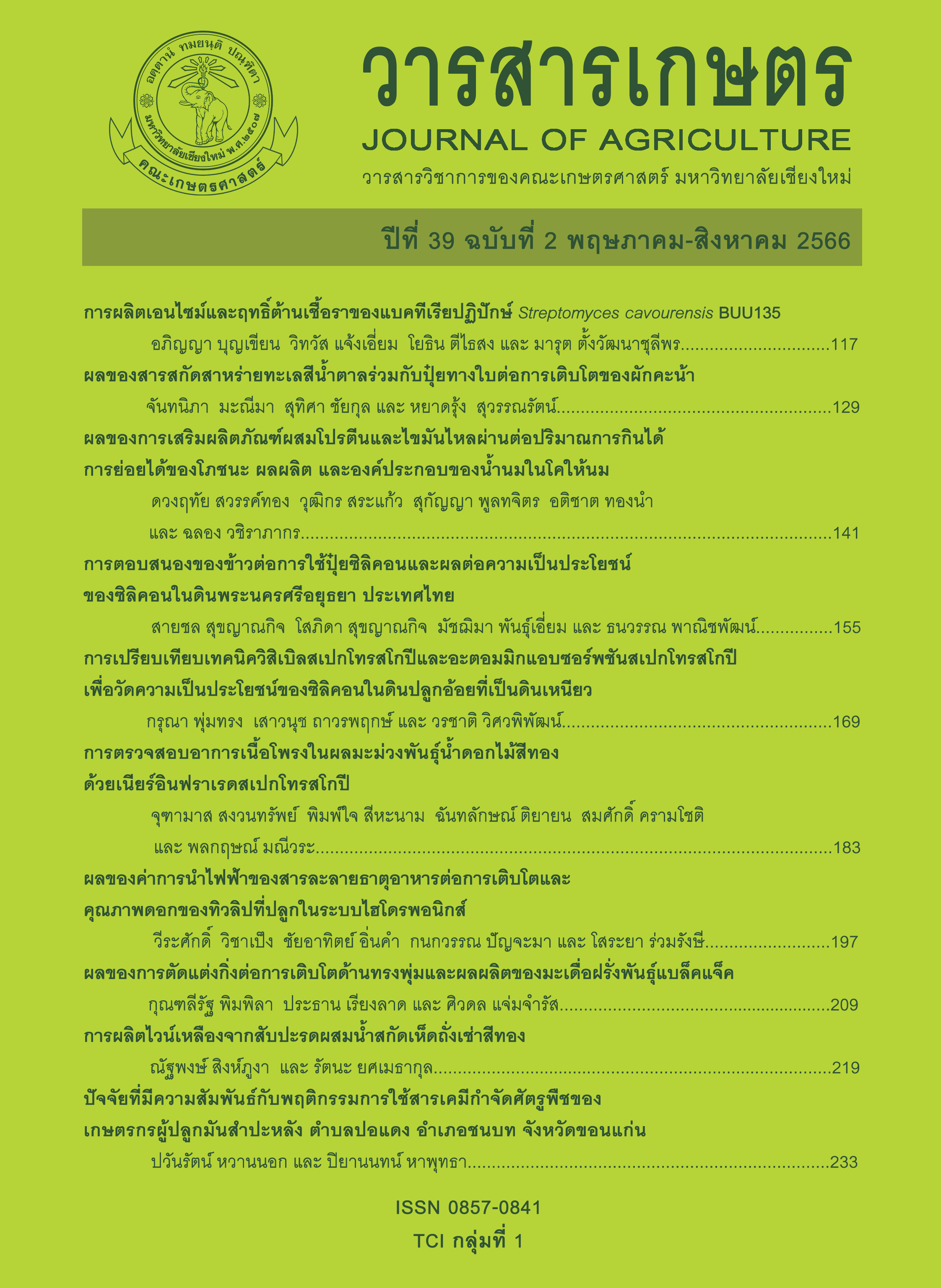Yellow Wine Production from Pineapple Mixed with <I>Cordyceps militaris</I> Extracted
Main Article Content
Abstract
This research aims to develop the yellow wine from pineapple juice mixed with extract of Cordyceps militaris and to study the consumer’s preference of the wine. Five ratios of pineapple juice and the extracted C. militaris were 1 : 9, 7 : 3, 5 : 5, 3 : 7, and 9 : 1 (v/v). Distilled water was used as a control in this experiment. The total soluble solid (TSS) of substrates was adjusted by adding sugar to 22 ºBrix, and the pH was adjusted at 5.5. Saccharomyces cerevisiae was fermented by using 10% inoculum as starter for 15 days at 30 ºC. Samples were randomly taken at every 3 days during fermentation and after 30 days of incubation to measure alcohol content, total soluble solids (TSS), total acid content, pH, color, and bioactive compounds (adenosine and cordycepin analysis). It was found that wine contained between 9.76 to 12.23 percent alcohol, TSS in range of 5.56 to 10.63 ºbrix, pH in range of 3.64 to 4.23 and acid percent in range of 0.57 to 0.70 after 15 days of fermentation. The result of wine physical test showed the highest yellow value (b*) of 48.11 from the ratio of pineapple juice and extract of C. militaris at 9 : 1 (v/v). The content of bioactive compounds including adenosine and cordycepin; both of them were decreased with increasing fermentation time. However, adenosine and cordycepin were able to detect in range of 349.08-546.89 mg/kg and 260.20 - 372.49 mg/kg, respectively after 15 days of fermentation. The yellow wine from pineapple juice mixed with extract of C. militaris at 9:1 (v/v) showed the highest color. The result of satisfaction test was found that score of 8.60. The other satisfactions of wine including clarity, odor, and flavor in all treatments showed the average scores in the same criterion (moderately like) while the overall liking was obtained the highest average scores at 8.67 from the ration of pineapple juice per extract of C. militaris with 9 : 1 (v/v).
Article Details

This work is licensed under a Creative Commons Attribution-NonCommercial-NoDerivatives 4.0 International License.
References
AOAC. 2000. Official Methods of Analysis of AOAC International. 17th ed. Association of Official Analytical Chemists, Arlington, Virginia.
Boondaeng, A., S. Kasemsumran, K. Ngowsuwan, P. Vaithanomsat, W. Apiwatanapiwat, C. Trakunjae, P. Janchai, S. Jungtheerapanich and N. Niyomvong. 2022. Fermentation condition and quality evaluation of pineapple fruit Wine. Fermentation 8(1): 11, doi: 10.3390/fermentation8010011.
Chaikulsareewath, A. and S. Singhapol. 2016. Wine production from pineapple mixed with carrot. Agricultural Science Journal 47(Suppl. 2): 165-169. (in Thai)
Chanprasartsuk, O., K. Pheanudomkitlert and D. Toonwai. 2012. Pineapple wine fermentation with yeasts isolated from fruit as single and mixed starter cultures. Asian Journal of Food and Agro-Industry 5(2): 104-111.
Chanthai, S. and P. Danvirutai. 2004. Chemical analysis of locally produced wines. Journal of University Academic Service Center 12(1): 23-29. (in Thai)
Chompookam, J., V. Subnum and T. Jaruwatanaphan. 2014. Effect of component ratio on coffee pulp wine quality and consumer’s satisfaction. Khon Kaen Agriculture Journal 42(Suppl. 3): 415-420. (in Thai)
Cunningham, K.G., S.A. Hutchinson, W. Manson and F.S. Spring. 1951. Cordycepin, a metabolic product from cultures of Cordyceps militaris (Linn.) Link. Part I. Isolation and characterization. Journal of the Chemical Society doi: 10.1039/JR9510002299.
Department of Agriculture Extension. 2021. Situation of pineapple production review. (Online). Available: https://www.oae.go.th/assets/portals/1/fileups/prcaidata/files/holdland%2063(3).pdf (May 15, 2021). (in Thai)
Huang, L., Q. Li, Y. Chen, X. Wang and X. Zho. 2009. Determination and analysis of cordycepin and adenosine in products of Cordyceps spp. African Journal of Microbiology Research 3(12): 957-961.
Jin, Z.-M., J.-J. He, H.-Q. Bi, X.-Y. Cui and C.-Q. Duan. 2009. Phenolic compound profiles in berry skins from nine red wine grape cultivars in northwest China. Molecules 14(12): 4922-4935.
Meilgaard, M.C., G.V. Civille and B.T. Carr. 2006. Sensory Evaluation Techniques, 4th ed. CRC Press, Boca Raton, FL. Riansa-ngawong, W. and S. Tipkanon. 2015. Development of golden rice wine by rice husk. Khon Kaen Agriculture Journal 43(4): 613-622. (in Thai)
Ribéreau-Gayon, P., Y. Glories, A. Maujean and D. Dubourdieu. 2006. Handbook of Enology, Volumn 2: The Chemistry of Wine Stabilization and Treatments. 2nd ed. John Wiley & Sons, Chichester. 441 p.
Shashidhar, M.G., P. Giridhar, K.U. Sankar and B. Manohar. 2013. Bioactive principles from Cordyceps sinensis: A potent food supplement-A review. Journal of Functional Foods 5(3): 1013-1030.
Tangtumniyom, K.1997. All About Wine. Duangkamol Printing, Bangkok. 248 p. (in Thai)
Tapingkae, T. 2012. Cordyceps Mushroom Cultivation. Two Four Printing Co., Ltd., Chiang Mai. 93 p. (in Thai)
Tuli, H.S., S.S. Sandhu and A.K. Sharma. 2014. Pharmacological and therapeutic potential of Cordyceps with special reference to Cordycepin. 3 Biotech 4(1): 1-12.
Wanapu, C., N. Boonkerd and L. Dithavibool. 2003. Winemaker 1. Somboon Printing Co., Ltd, Nakhon Ratchasima. 222 p. (in Thai)
Weil, M.K. and A.P. Chen. 2011. PARP inhibitor treatment in ovarian and breast cancer. Current Problems in Cancer 35(1): 7-50.
Zheng, P., Y. Xia, G. Xiao, C. Xiong, X. Hu, S. Zhang, H. Zheng, Y. Huang, Y. Zhou, S. Wang, G.-P. Zhao, X. Liu, R.J. St. Leger and C. Wang. 2011. Genome sequence of the insect pathogenic fungus Cordyceps militaris, a valued traditional Chinese medicine. Genome Biology 12: R116, doi: 10.1186/gb-2011-12-11-r116.


